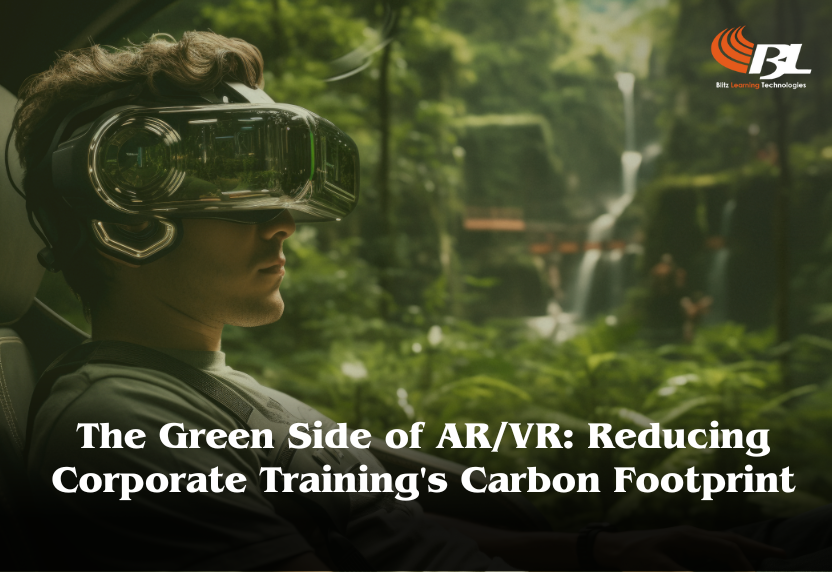
Blog
- Home
- Blog

31Jan
The Green Side of AR/VR: Reducing Corporate Training's Carbon Footprint
Introduction
In today’s rapidly evolving corporate world, companies are always looking for innovative ways to enhance employee training programs while being mindful of their environmental impact. As sustainability becomes a top priority, organizations are increasingly turning to Augmented Reality (AR) and Virtual Reality (VR) to reduce their carbon footprint in training environments. Although these technologies have primarily been linked to immersive experiences, they also provide an environmentally friendly way to meet the increasing need for corporate training initiatives.
The Environmental Costs of Traditional Corporate Training
Conventional business training frequently comes at a high environmental cost. Employees must travel to a central location for on-site training, which raises transportation-related emissions. Furthermore, waste and excessive carbon emissions are caused by the usage of printed materials, lodging, and other physical resources. The environmental impact is further increased by the practicalities of setting up training sessions, such as scheduling physical resources and renting venues.
Furthermore, typical training approaches are sometimes time-consuming, requiring businesses to retrain staff members or hold several sessions for various groups. This increases the carbon footprint linked to these activities in addition to wasting important resources.
AR/VR: A Sustainable Solution
AR and VR technologies offer a game-changing approach to corporate training by virtualizing the entire process. Employees can engage in realistic, interactive training sessions from anywhere in the world, reducing the need for travel and lowering the associated carbon emissions. With AR and VR, workers can experience hands-on simulations, making training more effective while bypassing the need for physical resources. This not only reduces emissions but also decreases waste, such as paper, plastic, and electronic waste generated by traditional training methods.
Remote Training with AR/VR: No Travel Required
The most obvious environmental benefit of AR/VR in corporate training is the reduction in travel-related carbon emissions. Traditionally, corporate training may require employees to fly to a centralized location or commute long distances. These activities contribute heavily to an organization’s carbon footprint.
With AR/VR, employees can participate in immersive, virtual environments, allowing for highly effective training without the need for travel. Whether it’s a safety procedure, machinery operation, or customer service simulation, AR/VR provides a dynamic, virtual environment for learning that cuts down the need for physical presence, thereby reducing fuel consumption and associated greenhouse gas emissions
Reducing Resource Consumption with Virtual Training
The ability to conduct training without relying on physical materials, such as printed books, manuals, and handouts, also contributes to a more sustainable approach. Traditional training often requires extensive paper use, and companies need to print thousands of copies of training materials, only for them to be discarded or outdated quickly. With AR/VR, companies can create virtual materials that can be easily updated, reducing the need for constant printing and minimizing waste.
Moreover, VR can simulate scenarios that would otherwise require expensive or potentially hazardous physical environments, such as training on machinery or hazardous operations. This eliminates the need for physical infrastructure and the associated resources, such as energy and raw materials.
Conclusion
AR and VR technologies are not only transforming corporate training programs in terms of interactivity and effectiveness, but they also present a clear path to reducing the environmental impact of training initiatives. By eliminating the need for travel, reducing paper waste, and creating virtual training environments that replace physical resources, AR/VR is helping organizations cut down on their carbon footprint. As sustainability continues to be a primary concern for businesses worldwide, incorporating AR/VR into corporate training is a significant step toward achieving greener practices while still delivering high-quality, engaging learning experiences. The green side of AR/VR is undeniably paving the way for a more sustainable future in corporate training.

Neha Khare
About authorNeha Khare specializes in designing engaging and effective learning experiences tailored to learners' needs and also creates insightful blogs on corporate e-learning. She develops creative instructional methods, integrates multimedia, and aligns content with learning goals. Neha's innovative techniques and blog contributions significantly enhance the quality and impact of corporate training programs.



Leave a comments